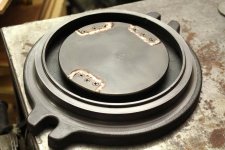awake
Titanium
- Joined
- Jan 24, 2006
- Location
- Angier, North Carolina
I recently acquired a 1970's vintage Series I BP that came with a Palmgren vise. I was under the impression that this was not all that good a brand of vise, but maybe this one was made in the good old days - it is very large (7" capacity), very heavy, very smooth, and clamps parts up very nicely indeed with very little tendency to rise up on clamping.
But sometime in its past, someone over-torqued the bolts holding the vice to its swivel base, and broke out a chunk from the inner rim of the swivel base circular T-slot. Not once, not twice, but three times - ! And of course, two of the breaks are right where I need to position the bolts for the vice to be parallel to the bed. Material is cast iron.
I have milled the broken areas to make pockets at the same depth as the bottom of the rim, and have machined pieces of cast iron to fit the pockets, with enough overhang that I can mill them to match the curve of the rest of the rim. My plan is to drill and tap screws to help secure the patches in place. Two questions:
1) Anyone care to recommend the optimal size of screw to use? I was thinking 8-32 ... would 10-32 be better? The pockets have a minimum of 1/2 inch of flat for the patches to sit on, into which the screws can be secured. (Plenty of thickness underneath, fortunately.)
2) I'm thinking it would be wise also to use some sort of adhesive. Currently the patches fit snugly in the pockets, but of course I can trim them to leave a little gap around the sides ... but I don't think there is any good way to leave a gap on the bottom - once I screw the patches in place, they will sit firmly on the bottom. So ... best choice for adhesive? I have some JB Weld on hand, but wasn't sure that it would do much good if it is all squeezed out on the bottom. Some sort of Loctite? I have some "red" threadlocker on hand, but I'm guessing that's not the best choice; I'd have to order anything else.
Incidentally, I did search before asking - found some interesting threads on various adhesive questions, but nothing that quite fit my situation, and I didn't succeed in finding anything regarding question 1.
But sometime in its past, someone over-torqued the bolts holding the vice to its swivel base, and broke out a chunk from the inner rim of the swivel base circular T-slot. Not once, not twice, but three times - ! And of course, two of the breaks are right where I need to position the bolts for the vice to be parallel to the bed. Material is cast iron.
I have milled the broken areas to make pockets at the same depth as the bottom of the rim, and have machined pieces of cast iron to fit the pockets, with enough overhang that I can mill them to match the curve of the rest of the rim. My plan is to drill and tap screws to help secure the patches in place. Two questions:
1) Anyone care to recommend the optimal size of screw to use? I was thinking 8-32 ... would 10-32 be better? The pockets have a minimum of 1/2 inch of flat for the patches to sit on, into which the screws can be secured. (Plenty of thickness underneath, fortunately.)
2) I'm thinking it would be wise also to use some sort of adhesive. Currently the patches fit snugly in the pockets, but of course I can trim them to leave a little gap around the sides ... but I don't think there is any good way to leave a gap on the bottom - once I screw the patches in place, they will sit firmly on the bottom. So ... best choice for adhesive? I have some JB Weld on hand, but wasn't sure that it would do much good if it is all squeezed out on the bottom. Some sort of Loctite? I have some "red" threadlocker on hand, but I'm guessing that's not the best choice; I'd have to order anything else.
Incidentally, I did search before asking - found some interesting threads on various adhesive questions, but nothing that quite fit my situation, and I didn't succeed in finding anything regarding question 1.



